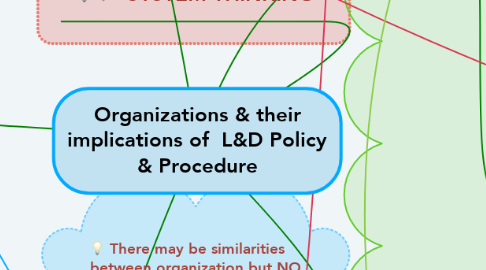
1. Meet Your Peers
1.1. An opportunity to self reflect
1.2. know the diversified group members
2. There may be similarities between organization but NO TWO ORGANIZATIONS ARE SAME
3. My Organization
3.1. how to Define organization
3.1.1. Ownership
3.1.1.1. Private, Voluntary, Franchise, Public
3.1.2. Reach
3.1.2.1. National, International , Local, Global, Regional
3.1.3. Age
3.1.3.1. Start-up, Immature, Mature
3.1.4. Evolution
3.1.4.1. Dynamic , Static, Adaptive
3.1.5. Service Delivery
3.1.5.1. Online, Face to Face
3.1.6. Client focus
3.1.6.1. B to Client , or B2B
3.1.7. Segregate organization into Sectors
3.1.7.1. Retail
3.1.7.2. Banking/Finance
3.1.7.3. Public Sector
3.1.8. Henry Mintzberg 5 structure configauration
3.1.8.1. Adhocracy
3.1.8.2. Divisional form
3.1.8.3. Professional (Bureaucracy)
3.1.8.4. Machine (Bureaucracy)
3.1.8.5. Simple
3.1.9. Tool to analyze your Organization
3.1.9.1. SWOT Anaylsis
3.1.9.2. PEST Analysis
3.2. My Organization's L&D statement
3.2.1. The Golden Thread
3.2.1.1. Understanding organization's Purpose, Strategy and goals
3.2.1.1.1. Understanding whats happening actual on ground issues, blockers
3.2.1.2. Task you perform and their relationship with Organization on ground issues, blockers
3.2.1.2.1. Task you perform and their relationship with organization purpose strategy and goals
4. Learning is the Heart of Organization
5. SYSTEM THINKING
6. Sector effects L&D Policy and Practice
6.1. Retail
6.1.1. learn any time , any where
6.1.2. Creativity
6.2. Banking
6.2.1. Providing evidence of Learning( Learning Analytics ) collecting data for effectiveness of learning. Using 70-20-10
6.2.2. Compliance with regulatory authorities
6.3. Public
6.3.1. Developing of L&D Strategy
6.3.1.1. set SOP and policies
6.3.2. Ownership by creating own learning in the workplace and practice 70-20-10
6.3.3. Learning plans of 6-12 months
6.3.4. Policies as learning solutions for the organiztion
6.4. Hospitality
6.4.1. Structure practices and Systems
6.4.2. Learning tracking system and regular process audits
6.4.3. aligning of career progression with organization and individual success
7. L&D
7.1. Real-time Challenges face by L&D Professionals
7.1.1. Retail
7.1.1.1. Staff always on the floor(Always working)
7.1.1.2. Diversified knowledge required to cover all aspects
7.1.1.3. Digitization, Fast paced Technology revolution
7.1.1.4. justify Return on Investment
7.1.2. Banking
7.1.2.1. Fast Paced regulatory requirement
7.1.2.2. Constant Innovation
7.1.2.3. Technological revolution , Addition of Social media
7.1.3. Public sector
7.1.3.1. Restriction such as rules ,code & regulations to be followed
7.1.3.2. Multi Layers of scrutiny
7.1.3.3. Diversified needs because international coverage and different nature and size of offices
7.1.4. Hospitality Industry
7.1.4.1. Participation
7.1.4.2. Duration of learning
7.2. CIPD Determinants of effective learning
7.2.1. Learning Informed by insights & Data
7.2.2. Consider Unique learner needs
7.2.3. Continuous review of learning design, delivery
7.2.4. Measure Effectiveness throughout learning process
7.2.5. Design & Deploy learning rapidly
7.2.6. All time accessible
7.2.7. Room for pre-thinking experimentation & reflection
7.2.8. Create Multimedia environment
7.2.9. Use findings from behavioral science
7.2.10. An Interesting anxiety- free environment
7.2.11. Room for Self Direction and learner exploration
7.2.12. Communities and Conversation encouraged
7.2.13. Personal resilience and promotes well being
8. How to over come these challenges
8.1. Retail
8.1.1. Blended Learning
8.1.1.1. Technology
8.1.1.2. classical learning methodogies
8.1.2. Bite size learning
8.1.2.1. Make it accessible to staff all the time
8.1.3. Creating a culture of learning
8.2. Banking
8.2.1. Invest in yourself
8.2.2. Find Strategic partners
8.2.3. Constantly update yourself
8.3. Public
8.3.1. Flexible learning solutions
8.3.2. Self facilitation , L&D Champions
8.3.3. Online Access to courses
8.3.4. Acknowledging Culture , Age groups and its affects on L&D
8.3.4.1. Classroom, Certification & qualifications
8.3.4.2. Bite sized learning, Social learning, digital certifications
8.4. Hospitality
8.4.1. Better communication with all the stake holders
8.4.2. Using 70-20-10 concept showing direct importance of Manager
9. Philosophy of learning
9.1. WHY?
9.1.1. Why Learning is important for organizaion
9.1.1.1. Highlight learning is driving Strategy, goals , performance and competitive Advantage
9.2. WHAT
9.2.1. What organization want to achieve from learning
9.3. WHO
9.4. WHEN
9.4.1. Define roles , needs , priorities
9.4.2. Life long process
9.4.3. Induction , promotion
9.4.4. Leaning in working hours or in off hours
9.5. Where
9.5.1. Face to Face
9.5.2. in flow of work
9.5.3. Technology
9.5.4. Formal and informal learning
